Christmas in April
- Allan Sander

- Apr 15, 2024
- 7 min read
Updated: Apr 16, 2024

Grevillea spartina is a tree native to Australia, with an ancient lineage. It has atypical blooms, no petals, instead the calyx are tube-like and arranged like the bristles of a brush. In Victoria it is sometimes referred to as the Victorian Christmas Tree, the time of year it is filled with intense yellow-orange colorations. It attracts native insects and birds, like honeyeaters. They poke their heads into its flowers for a high caloric drink of nectar and protein packed pollen. Some of the grains adhere to the bird’s feathers and cross-pollination results as it hops from flower to flower in search of more sweet libations. There are no honey-eaters on this side of the world, but there are plenty of critters here in search of a sugar-fix!
This is an ideal time up on ‘Lone Tree Hill,’ as it is referred to at times. Otherwise I am in the middle of the “Urban Forest” section of the San Joaquin Marsh Wildlife Sanctuary [SJMWS] owned by the Irvine Ranch Water District in southern California.


Large numbers of passerine migrants pass through in April. Before continuing the journey north they need to refuel their energy stores.
Three Silky Oaks (G.spartina) are dripping with nectar and their towering presence acts like a beacon attracting these weathered travelers. As the weeks progress so too does the avian participants.
The locals are always first in line. Always the opportunist, I am accustomed to see Mockingbirds (Mimus polyglottos) a little heavy on the rouge, a result of digging into the fruits of prickly pear cactus in the fall. This time of year it is dusted in yellow, a much better match for its pale-yellow eyes.

A male House Finch (Haemorhous mexicanus) makes a debut, wearing his own splash of red.

Lesser Goldfinch (Spinus psaltria) always seem to alight atop the crown; they never stay very long. I so hoped for a flock of Cedar Waxwings (Bombycilla cedrorum) to drop in but only once did a lone bird make an appearance. Still, how fun to view these sleek crested birds, wearing a black mask, with satiny, smooth plumage that flows from brown to gray, their belly washed in yellow as is the tip of the tail, and the namesake red tips in some wing feathers as if dipped in wax (However they are missing on this bird.).

The Urban Forest is more like a Botanical Garden. Mixed in with the local fauna are many exotics. Immediately stepping onto the Treehill Trail from the parking lot, I was greeted by several Red Silk-cotton Trees (Bombax ceiba). The large, fleshy red flowers are also a great source of nectar. Opposite Brazilian Pepper Trees (Shinus terebinthifolia) intermingle with the native forest. As I continue my walk twin towering Yellow Fever Trees (Acacia xanthophloea) cut the shadows with long white thorns amid its tangle of branches. Further along on the right large pods of the Kapok Trees (Ceiba pentandra) are starting to split, bursting with cottony fibers that can be used for insulation or stuffing for pillows and mattresses.

Not much further two G. robusta are positioned before me. Here I stand, my camera-tripod [C-T] mount set at its full extension, focused above on gilded boughs salivating with nectar. Another year-round resident, the Orange-crowned Warbler (Leiothlypis celata), was most prevalent.

The olive-yellow feathers blend nicely among the leaves. Any type of movement within the canopy can reveal a surprise. Generally the bird will attempt to perch closest to the blooms; they are too sticky to settle on. At times it will rubber-neck itself or gracefully arc its head downward between the colorful lobes.
The most acrobatic are the white-eyes (Zosterop’s simplex), they will go as far as to hang upside down to get their fill.

Of course the nectar aficionados, the hummers, were in constat flux; greedily sparring over more territory than necessary. Allen’s (Selasphorus sasin) outnumbered Anna’s four to one.
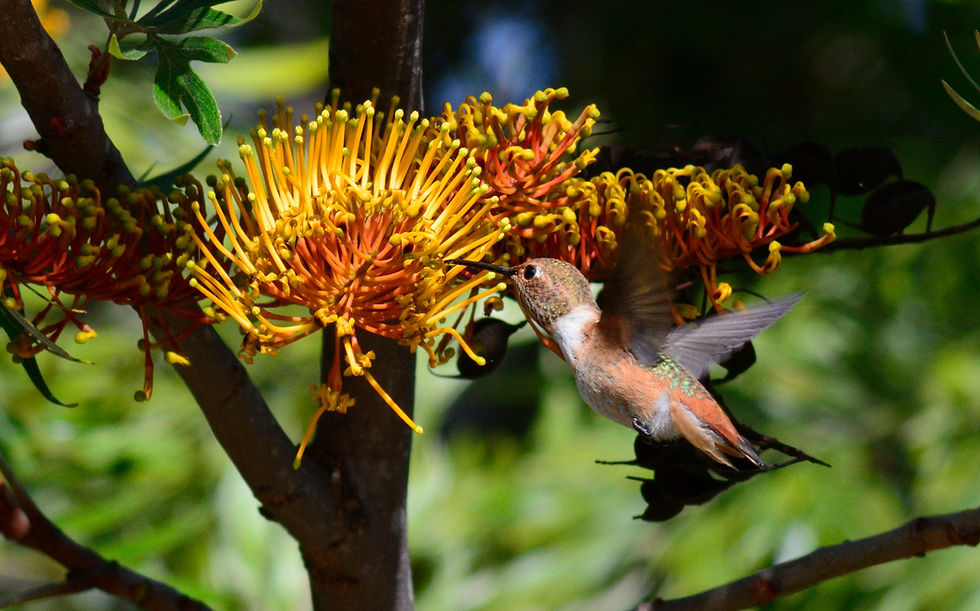
Nearby, another Australian native, the Bottlebrush Tree (Callistemon species) is humming with activity. There were moments I was torn between which trees to concentrate on!


It is as if the birds are on a sugar high, darting from one floral cluster to another. An observer would be scratching their head [or do an about- face], as they watch me dancing with my C-T in order to capture the action. Here is an Anna's Hummingbird (Calypte anna) getting its fill.
An Orange-crowned Warbler “Strikes a Pose,’ before shuffling back into the shadows.

Then, a Bushtit (Psaltriparus minimus) glides in but appears to be in pursuit of the warbler.

I wait for an outcome but a Hooded Oriole (Icterus cucullatus) grabs my attention.


Upon leaving, another Bushtit presented itself in a pepper tree; it had a bill-full of nesting material. It shifted position and flew into the heart of the flaming bottlebrush tree. That explains it!
Another early participant is one of our ‘snowbirds,’ a.k.a. Yellow-rumped Warbler (Setophaga coronata). Some males are in breeding plumage, adding more color to the gala.

When tracking a Yellow Warbler (Setophaga petachia), it feels as if I am hastily playing “Connect the Dots” with a beam of light.
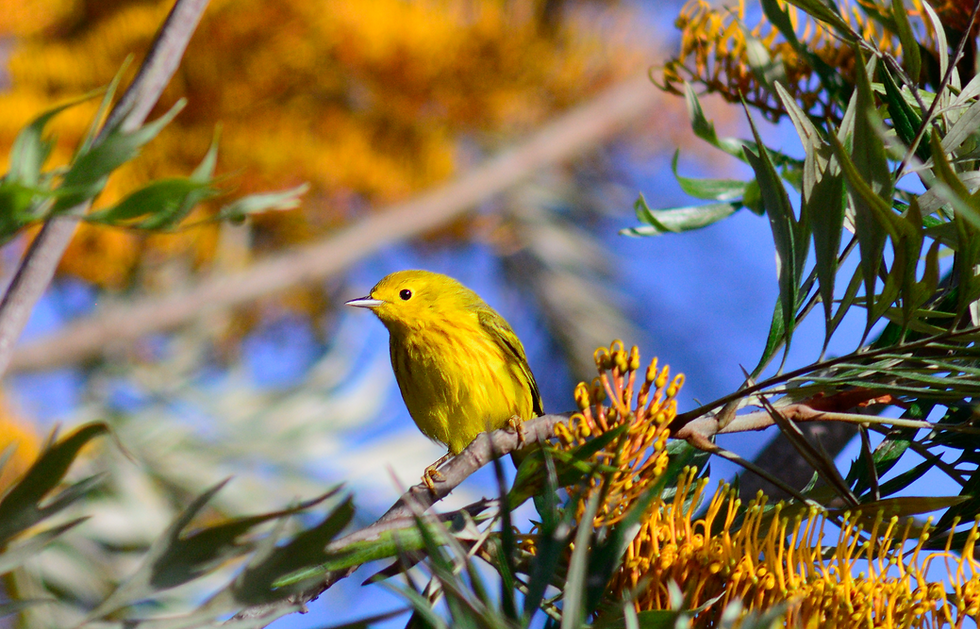
The Wilson’s Warbler (Cardellina pusilla) generally zig-zags in lower vegetation, but it seems this early season “Happy Hour!” cannot be ignored.

Back at the Bottlebrush tree, the hummers continue their zip-line behavior.

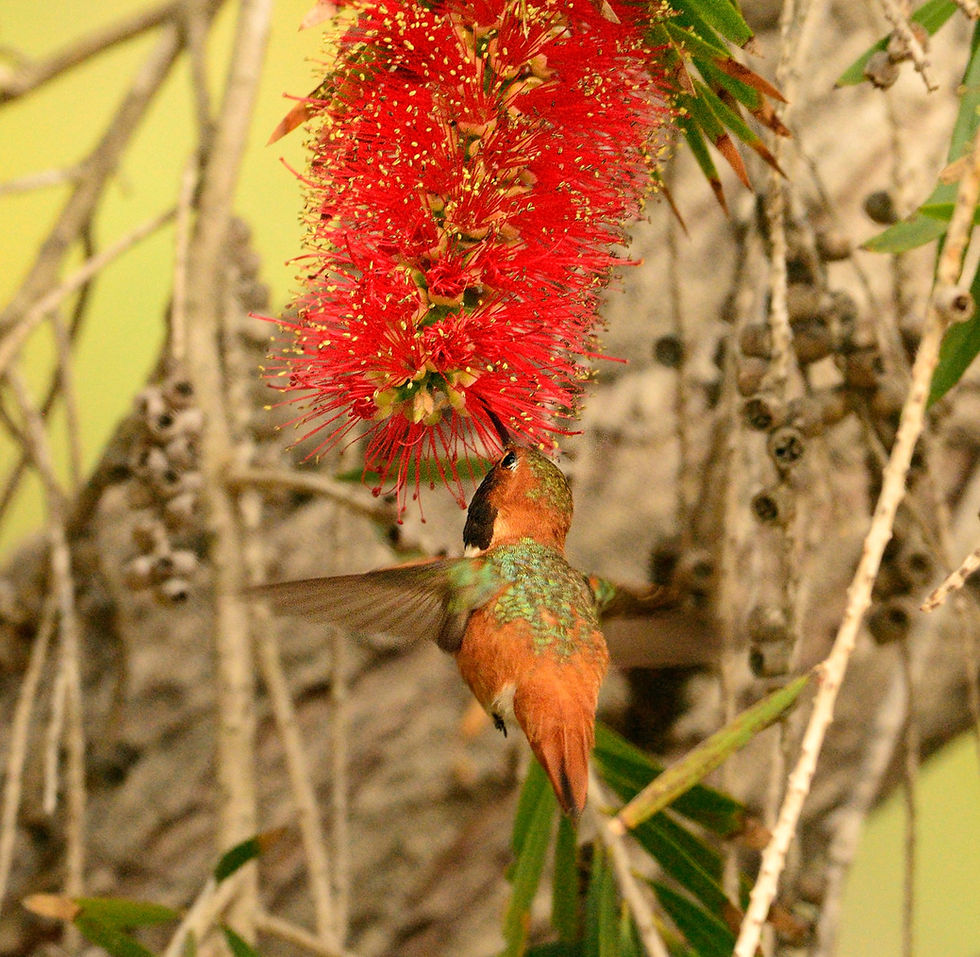
Probing between the filaments is another Orange-crowned, a little more paced than....
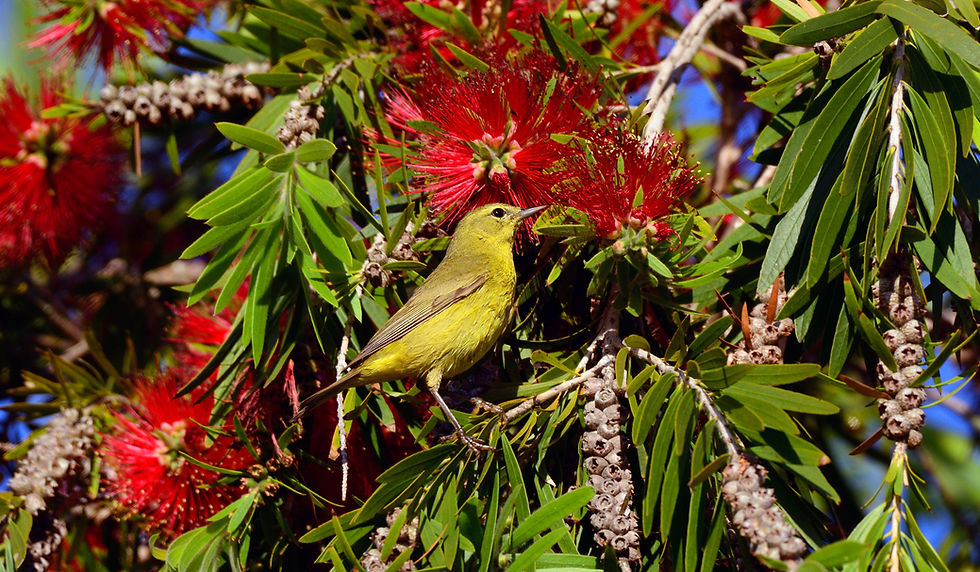
....the nervous feeding style of the White-eye.

The next guest appearance comes from Nashville (Leiothlypis ruficapilla), the warbler that is; the title was given to it by the ornithologist, Alexander Wilson - the location where he first discovered the bird.

Returning to the Silky Oak, its orange sunshine has attracted a Townsend’s Warbler (Setophaga townsendi); again, named after an ornithologist/collector.

I am just as 'wound up' as the birds, “Where do I go next?!” As I am about to leave, a familiar call reveals a Hutton’s Vireo (Vireo huttoni).

In the background from out of the bush emerges a Desert Cottontail (Sylvilagus audubonii); it appears to have a desire to partake in a patisserie of sorts - standing on hind legs allows it to reach a cluster of tender white petals.

There are more call notes than song, but a Mockingbird has been belting out its compilation of both, from all sorts of species of birds. I find this mimic stationed in one of the acacias.

Another week, another adventure! The first action on arriving is to check in on the nesting bluebirds (Sialia mexicana). The female pokes her head out from the nestbox as her mate perches vigilantly nearby.


As I position to take some snapshots a loud, “Killdeer!” rings out! Behind me is the plover (Charadrius vociferus), it has its tail splayed and hobbles along feigning a broken wing.

“O.K. Where is it!” I tell myself. I search until three brilliantly camouflaged eggs mystically emerge from the woodchip substrate.

Here is what you are looking for...
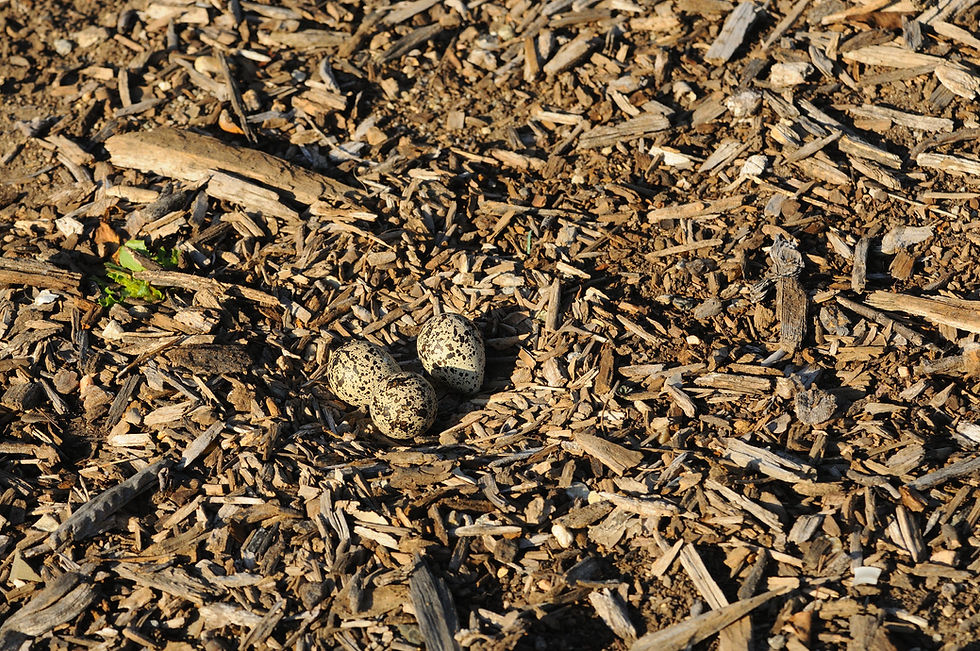
As I get closer, the sounds of grosbeaks and tanagers can be heard. I prop up my C-T and find these two songsters. Hats off to the Black-headed Grosbeaks (Pheucticus melanocephalus) for wearing their complimentary coats of brown and black.
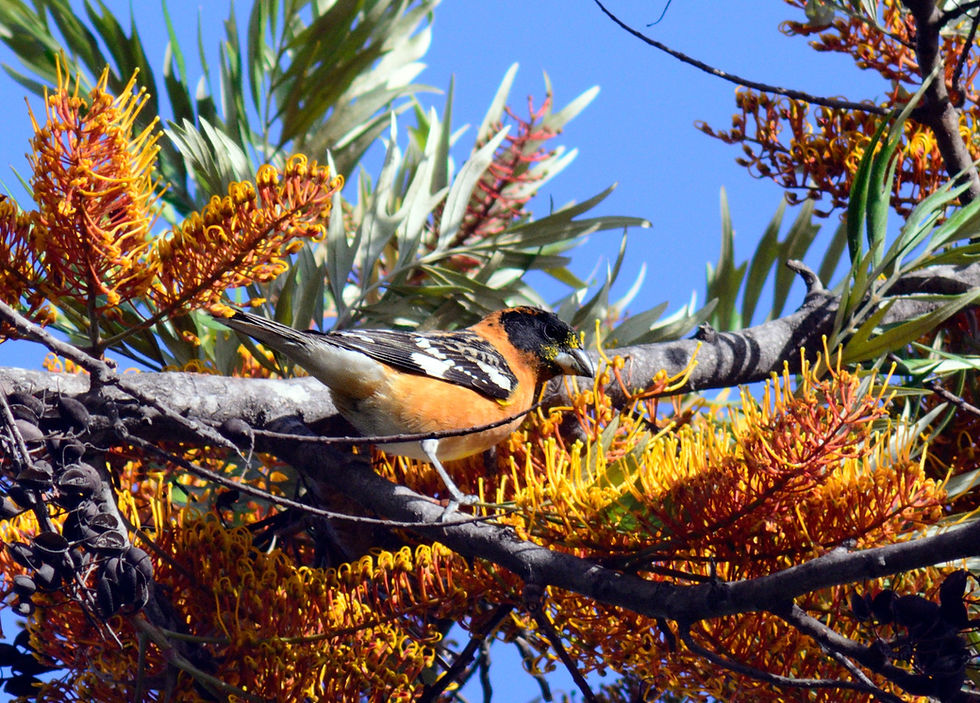


And the yellow-and-black plumage of the tanager (Piranga ludoviciana) with their burnt orange faces adds more fuel to the flames of the Silky Oaks.



The birds seem a tad skittish so I follow suit to search for a singing chat (Icteria virens); its song easily distinguishable with a disjointed mix of squawking, twittering, chatting, chortles, and whistles.

Looping back to an acaia tree I encounter an Ash-throated Flycatcher (Myiarchus cinaracens)

along with a spritely Empidonax species. I barely manage a few shots before it high-tails it back into the darkness. Thank goodness for digital review. It appears it is a Hammond's Flycatcher (Empidonax hammondii).

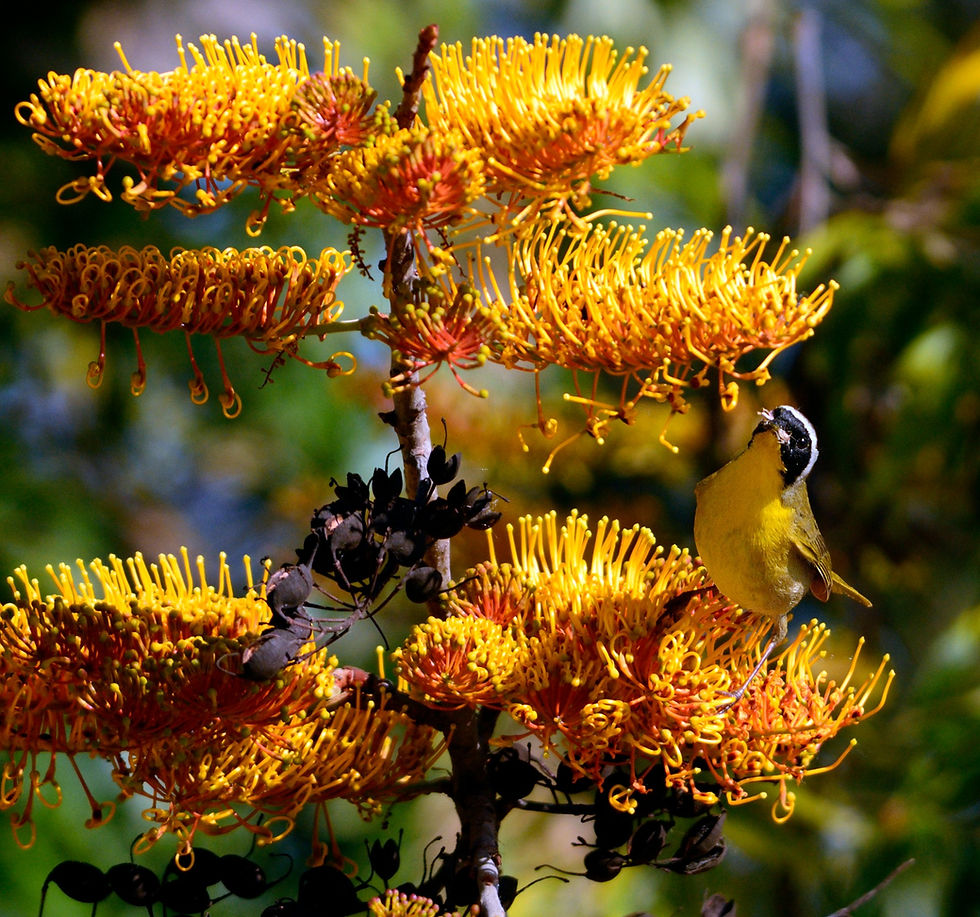
Up in the two major flowering trees from Aussie Land, I was surprised to find two species of birds normally skulking around amid low growth vegetation.
It was difficult to see any invertebrates but leave it to a Yellowthroat (Geothlypis trichas) to find a delectable ornament among the branches.

Perhaps the same can be said for Melospiza melodia, the Song Sparrow, as it gazes over the filaments of a bottlebrush bloom.
I must retract my ‘bug’ remark, earlier the delicate adornments of a Tiger Swallowtail (Papilio rutulus) did drift in for a nourishing drink.
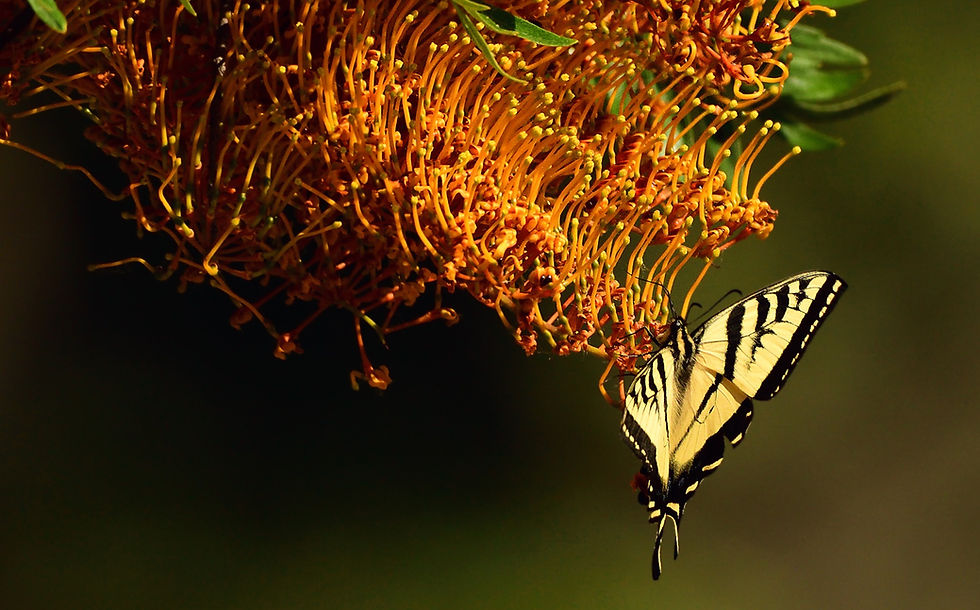
A bubbly, ‘call’ note tickles my ear – I am led to an adjoining pine. For me, this ‘call’ denotes five species of warbler donning a black-throat/bib in the genus Setophaga.

Out west has three species: Black-throated-gray (Setophaga nigrescens), Townsend’s, and Hermit.The Golden-cheeked breeds in the Edward’s Plateau in Texas and the Black-throated-green in the eastern portion of the U.S. and Canada. My ears do not deceive me, it is Setophaga occidentalis, the Hermit. It is always an exciting find. Before I know it, “Off it goes!”
Not a bad idea, back to base camp. I feel like a pinball, going from bottlebrush to oak; recoiling between red and yellow with all of the avian plumages in between. It felt like I was riding that psychedelic bus from the 60’s! During this flashback, I thought I saw a Yellow-breasted Chat jump into the scene. “Sure enough!” Those white spectacles give me a glance before it drops out of sight.

Patiently I wait, focusing on another part of the tree, the sun breaks and the bird obliges with another quick cameo before it takes flight.

Stage right, black-and-yellow facial contours of a Townsend’s Warbler add more drama to the scene.

“Another fifteen minutes,” I tell myself. It continues for half an hour enjoying one performance after another, it may be the same routine but it is always a fresh experience. That’s when a Hermit Warbler hops into the act, choosing the higher branches to forage for several minutes before heading backstage.

How fortunate, a joy to watch!


The gifts did indeed keep coming this April. I look forward to next year’s festivities!
Location: The 'Urban Forest' of the San Joaquin Marsh Wildlife Sanctuary in Irvine, California - USA Date: April of 2016 and 2019 Websites:



Comments